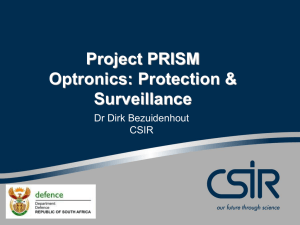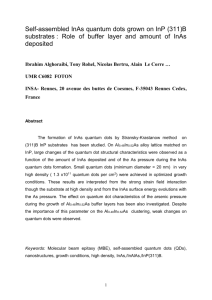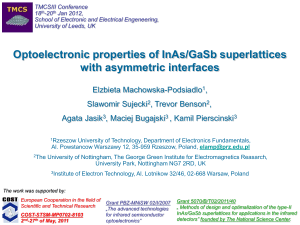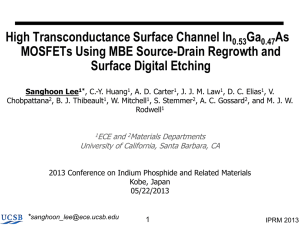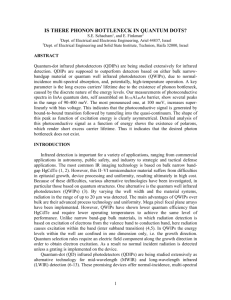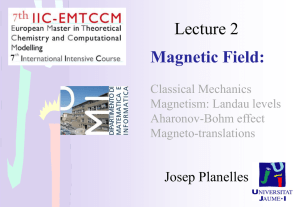Obtention of isolated self-assembled InAs/InP(001) quantum wires
advertisement
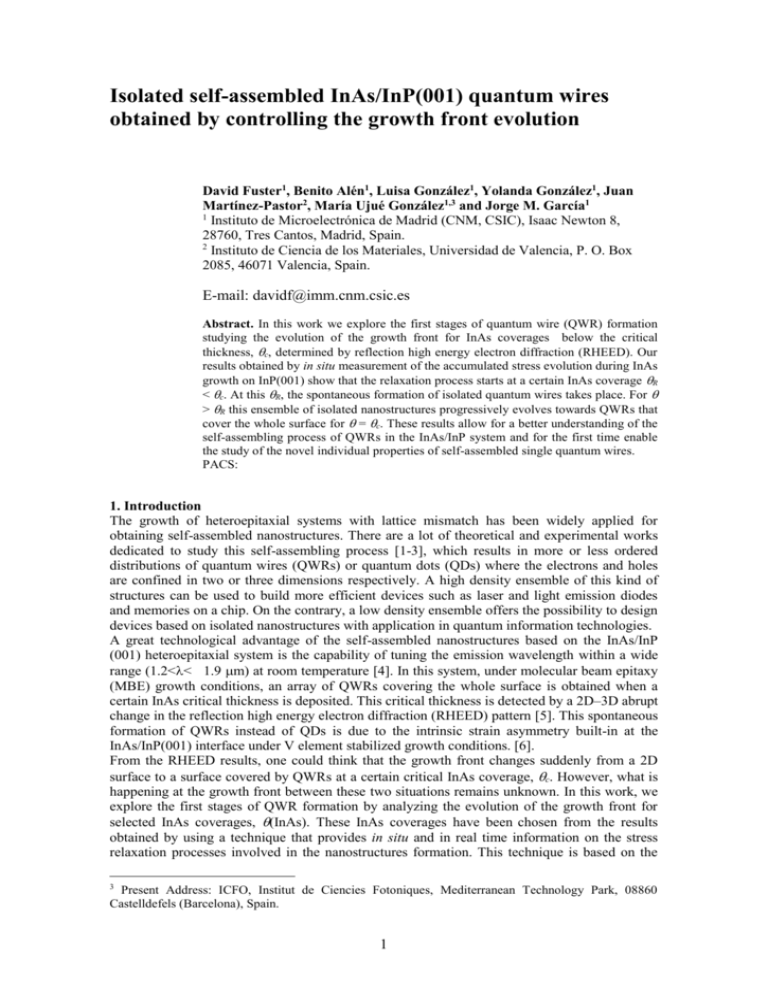
Isolated self-assembled InAs/InP(001) quantum wires obtained by controlling the growth front evolution David Fuster1, Benito Alén1, Luisa González1, Yolanda González1, Juan Martínez-Pastor2, María Ujué González1,3 and Jorge M. García1 1 Instituto de Microelectrónica de Madrid (CNM, CSIC), Isaac Newton 8, 28760, Tres Cantos, Madrid, Spain. 2 Instituto de Ciencia de los Materiales, Universidad de Valencia, P. O. Box 2085, 46071 Valencia, Spain. E-mail: davidf@imm.cnm.csic.es Abstract. In this work we explore the first stages of quantum wire (QWR) formation studying the evolution of the growth front for InAs coverages below the critical thickness, c, determined by reflection high energy electron diffraction (RHEED). Our results obtained by in situ measurement of the accumulated stress evolution during InAs growth on InP(001) show that the relaxation process starts at a certain InAs coverage R < c. At this R, the spontaneous formation of isolated quantum wires takes place. For > R this ensemble of isolated nanostructures progressively evolves towards QWRs that cover the whole surface for = c. These results allow for a better understanding of the self-assembling process of QWRs in the InAs/InP system and for the first time enable the study of the novel individual properties of self-assembled single quantum wires. PACS: 1. Introduction The growth of heteroepitaxial systems with lattice mismatch has been widely applied for obtaining self-assembled nanostructures. There are a lot of theoretical and experimental works dedicated to study this self-assembling process [1-3], which results in more or less ordered distributions of quantum wires (QWRs) or quantum dots (QDs) where the electrons and holes are confined in two or three dimensions respectively. A high density ensemble of this kind of structures can be used to build more efficient devices such as laser and light emission diodes and memories on a chip. On the contrary, a low density ensemble offers the possibility to design devices based on isolated nanostructures with application in quantum information technologies. A great technological advantage of the self-assembled nanostructures based on the InAs/InP (001) heteroepitaxial system is the capability of tuning the emission wavelength within a wide range (1.2<< 1.9 m) at room temperature [4]. In this system, under molecular beam epitaxy (MBE) growth conditions, an array of QWRs covering the whole surface is obtained when a certain InAs critical thickness is deposited. This critical thickness is detected by a 2D–3D abrupt change in the reflection high energy electron diffraction (RHEED) pattern [5]. This spontaneous formation of QWRs instead of QDs is due to the intrinsic strain asymmetry built-in at the InAs/InP(001) interface under V element stabilized growth conditions. [6]. From the RHEED results, one could think that the growth front changes suddenly from a 2D surface to a surface covered by QWRs at a certain critical InAs coverage, c. However, what is happening at the growth front between these two situations remains unknown. In this work, we explore the first stages of QWR formation by analyzing the evolution of the growth front for selected InAs coverages, (InAs). These InAs coverages have been chosen from the results obtained by using a technique that provides in situ and in real time information on the stress relaxation processes involved in the nanostructures formation. This technique is based on the 3 Present Address: ICFO, Institut de Ciencies Fotoniques, Mediterranean Technology Park, 08860 Castelldefels (Barcelona), Spain. 1 monitoring of the accumulated stress evolution during the growth of a strained layer on a substrate by the measurement of the deflection of a cantilever shaped substrate [7,8]. Our results demonstrate that at a certain InAs coverage R < c the elastic relaxation process starts as detected by the above described technique. This onset of the relaxation process corresponds to the spontaneous formation of isolated QWRs as we observe by post-growth atomic force microscopy (AFM) characterization. When the amount of deposited InAs is increased, these isolated QWRs evolve towards longer wires that partially cover the surface until a full coverage is obtained for = c. These results provide a better understanding of the self-assembling process of QWRs in the InAs/InP system. At the same time, the samples partially covered by QWRs have enabled for the first time the study of the properties of single self-assembled one-dimensional structures. 2. Experimental The process of QWR formation has been monitored in situ by following the evolution of the accumulated stress along the [110] direction during solid source MBE of InAs on InP(001) [figure 1] [6]. The accumulated stress, , is quantitatively obtained by measuring the bending changes of a cantilever-shaped InP substrate held by one of its extremes. This stress-induced curvature radius change is determined, in real time, by measuring the angular deflection of two collimated and parallel laser beams impinging on the sample surface [inset figure 1] [6, 7]. Once the curvature radius change is measured, can be derived by means of the well-known Stoney's equation [8] . Under similar experimental growth conditions as those used in the measurement of evolution, we have grown two series of samples of InAs/InP(001) with selected values of (InAs): uncapped for topographic and capped for optical investigation. The samples were grown by solid source MBE and consist of InAs grown on InP(001). After a 180 nm-thick InP buffer layer the InP surface was exposed to As4 flux during 3 s at substrate temperature TS = 480 ºC. InAs was deposited at a deposition rate of 0.5 monolayers per second (ML/s), TS=480 ºC and beam equivalent pressure BEP(As4) = 4x10-6 mbar. After InAs deposition, the surface was annealed during 1.5 minutes under As4 flux. The samples for photoluminescence (PL) characterization were then covered by a 20-nm-thick InP cap layer grown by atomic layer MBE (ALMBE) at TS = 380 ºC, in order to obtain nanostructures with the emission wavelength at 1.55 µm [9]. The surface of uncapped samples has been measured by atomic force microscope (AFM) (Nanotec) in contact mode under air environment. The capped samples were characterized by photoluminescence (PL) using non-resonant excitation at 514.5 nm under low power conditions. The PL signal was dispersed by a 0.22 m focal length monochromator and synchronously detected with a liquid nitrogen cooled Ge detector. In order to resolve the emission of single isolated nanostructures we have used a confocal microscope based on two different single mode optical fibers that carry the laser and PL signals and act as pinholes (Attocube CFM-1). Mechanical drifts are minimized inserting both the sample and the high aperture lens (NA=0.5) in an He immersion cryostat. Resonant continuous wave excitation (950 nm) is provided by a tunable Ti-Sapphire laser. Finally, a nitrogen cooled InGaAs focal plane array (512x1 pixels, Jobin-Yvon IGA-300) attached to an 0.5 m focal length grating spectrograph is used for detection. 3. Results On Figure 1 we show the evolution of the accumulated stress, , along [110] during growth of InAs on InP(001). For search of clarity in the interpretation of the results, in our experiment, prior to In deposition, the InP surface was exposed during 3s to As flux. In these conditions, the As/P exchange process is largely promoted [10]. As shown in figure 1, for the growth conditions used, this process is responsible for an accumulated stress of ~1.2 Nm-1. Considering the variation in surface stress related to the change of surface material and surface reconstruction [7] as well as the stress incorporated by the formation of strained InAs, this amount of accumulated stress is compatible with the incorporation of around one ML of InAs 2 over the exposed surface. At this moment, the In cell is opened (t=0 in figure 1) and InAs begins to grow. Due to the 3.2% lattice mismatch between InAs and InP, starts to increase linearly with the amount of InAs deposited. This is what we observe on figure1, where the initial linear increase of corresponds to 0.77 Nm-1 of accumulated stress per ML deposited, very close to its theoretical value of 0.78 Nm-1ML-1 deduced from InAs/InP bulk elastic constants. As it is already well known, at a certain InAs coverage, R, the InAs two-dimensional layer is not energetically favourable anymore and relaxation starts by the formation of self-assembled nanostructures. In terms of the behaviour of , at this point the slope of the linear change in should decrease due to the stress relaxation produced by the changes in surface morphology. This is what we observe after deposition of 1.4 ML of InAs, where the slope of linear increase suddenly decreases even if the In deposition rate remains constant. The absence of a similar reduction in the accumulated stress signal measured along [1-10] (not shown) indicates that the relaxation is anisotropic; the critical accumulated stress is firstly achieved in [110] direction promoting the formation of QWRs that can efficiently relax the higher surface stress along this direction [6, 10]. Here it should be noted that RHEED monitoring does not show any trace of QWR formation at the exact point where the relaxation process starts, R. It is necessary to deposit 1.1 ML more of InAs to observe a 3D RHEED pattern (point F on figure1). The real time monitoring of the total accumulated stress shown in figure 1 is sensitive to the whole sample surface relaxation process giving a measurable signal long before the RHEED pattern does, thus providing earlier information about the relaxation process. This information is directly related with the nanostructures self-assembling process, as will be shown below. In order to study the interplay between the relaxation process and the evolution of the growth front morphology, several samples with (InAs) designed according to the singular points of the curve were grown. The arrows on figure 1 mark the values corresponding to the (InAs) chosen for samples A-F. We count with an InP bare surface corresponding to =0 (sample A) and a surface with that InAs coverage just formed by As/P exchange at =1.2 Nm-1 (sample B) by exposing the surface to the As4 flux during 3 s. Samples C-E have a (InAs) around the R , where stress relaxation starts (change of slope in ). The (InAs) of sample F corresponds to the strong relaxation observed, in coincidence with the 3D features in the RHEED pattern. So, for samples C-F we have varied the amount of InAs deposited on InP (001) using: 1.3, 1.5, 1.7, 2.5 ML respectively. However, we have to consider that the total amount of InAs in these samples is the result of the addition of the InAs deposited (from In and As atoms produced at the effusion cells) to the extra InAs that has been formed at the interface by As/P exchange (around 1 ML). So, the InAs coverage (InAs) of the samples grown for this study is the sum of both contributions. In this way, samples A-F have a (InAs) 0, 1, 2.3, 2.5, 2.7 and 3.5 ML, respectively. Figure 2 shows 1x1 m2 AFM images of the uncapped samples for 0 (InAs) 3.5 ML [figure 2 (a-f)]. The InP surface that we find before the As cell is switched on (sample A) is shown in figure 2(a). We can distinguish one-monolayer-high steps due to the unintentional miscut angle of the InP(001) wafer (~0.1º off). When the As flux arrives at the surface (sample B), the InAs surface produced by As/P exchange shows a more regular step distribution. After deposition of 1.3 ML of InAs [(InAs) = 2.3 ML] on that surface (sample C), 1 ML high islands elongated along [1-10] direction are formed starting at the step edges [figure 2(c )]. Similar structures were reported by exposing an InP surface to arsenic flux [11]. When nAs) increase just above R [(InAs) = 2.5 ML InAs, sample D], according to figure1, a relaxation process has been just activated and could coincide with the beginning of the 3D nanostructures formation. What we observe in the AFM image from sample D [figure 2(d)] is exactly the appearance of asymmetric isolated 3D structures. Apparently, upon an increment of (InAs) = 0.2 ML, the dendrites with 1 ML high at the step edge of sample C [see profile on Fig 2(c)] transforms into the isolated asymmetric structures [figure 2(d)]. As the previous dendrites, these isolated structures begin to form mainly at the islands edges (though a few of them have also been observed on the flat terraces). Due to the intrinsic built-in asymmetric strain at the 3 InAs/InP interface [6], the critical accumulated stress is firstly achieved in [110]; this happens when the InAs island edge reaches a height between 2 and 3 ML [see profile on figure 2(d)]. This result agrees with that reported by Porte [3] where the 2D-3D transition occurs when the number of ML at the islands edges (Nedge) reaches a critical value. However, along [1-10] the QWRs continue growing in length, even passing across the 1 ML step height of the 2D InAs terraces because in this direction the critical accumulated stress for elastic relaxation has not been reached yet at this InAs thickness. The average ratio length/width in sample D is around 8, but we can find longer wires as that shown in figure 2(d). Therefore, we consider that the studied nanostructures in this sample are 1D quantum objects rather than quantum dots. For the sample with (InAs) = 2.7 ML (sample E), we find isolated QWRs coexisting together with others that although being longer and narrower, remain constant in height [figure 1(c)]. A considerable rearrangement of the InAs layer is necessary for the isolated QWRs to transform into QWRs grouped in bundles where they appear periodically separated. The increase in length and density of the QWRs observed in this sample indicates a significant increment in the amount of InAs involved, even if only 0.2 ML has been added to the InAs deposited in sample D. Driven by stress relaxation, the short and isolated QWRs act as sinks for preferential InAs growth not only for the incoming In and As atoms, but also by promoting mass transport by enhanced diffusion from 2D areas to the 3D structures [4,12]. When the amount of (InAs) is increased up to 3.5 ML (sample F) we observe chevrons in the RHEED pattern, corresponding to the conventional concept of critical thickness. For this (InAs), a clear decrease with time for InAs constant thickness is observed on figure 1 (zone marked with “F”). This implies that relaxation along [110] continues after the growth interruption. In this situation, we obtain the well known array of QWRs covering completely the surface [figure 2(f)] [13]. A statistical study of the wire dimensions for more than 50 wires of samples D and F give a mean height (width) of 0.7± 0.2 nm (22± 5) and 1.1 ± 0.3 nm (12 ± 3) nanometres respectively (figure 3). These results indicate that during the evolution from isolated to fully developed QWRs, these nanostructures change in height and width. Based on the above discussed results (in situ measurements and post-growth AFM), we can identify different processes that starting from a flat InP(001) surface lead to a surface covered with periodically separated InAs QWRs. In particular, we have described how the onset of the elastic relaxation is linked to the formation of self-assembled isolated QWRs in the InAs/InP(001) system. This occurs at a R(InAs) much smaller than the critical thickness determined by RHEED, C. In this sense we can establish that in situ measurement technique is more sensitive than RHEED to detect the existence of small or low density nanostructures during growth. In the following, results of PL and micro-PL characterization from similar samples to those studied by AFM will be shown. As discussed later, the emission properties strongly support the proposed formation process of the InAs nanostructures as identified by AFM characterization. The PL results from the capped samples CC-FC [similar to samples C-F, figure 2 (c-f)] are shown in figure 4. All samples studied here show strong emission bands reflecting the high quality of the coherent (defect-free) self-assembled growth process. We can distinguish multiple peaks associated to the emission from two different structures: quantum wells (QWs) and QWRs as explained below. The PL spectrum of sample CC with a (InAs) = 2.3 ML (where QWRs have been rarely found by AFM) shows two main peaks [QW2 and QW3 in figure 4(a)]. We associate these two peaks to the emission from 2 and 3 ML high QWs arising from the 2D InAs islands that were measured by AFM in the surface of the corresponding uncapped sample [figure 2(c)]. This hypothesis is also supported by the fact that the emission energy of these two peaks nicely fits to the InAs/InP QW calculation modelled by Hopkinson et al [14] and not with our previously reported calculations on QWRs [15, 16]. In this sample, two low intensity PL peaks (P0 and P3) appears at the low energy side of the QW3 emission line, as observed in figure 4(a). At first, we associate them to the QWRs that are spread in the wide excitation laser spot area. In the PL spectrum from sample DC, the peaks related to the QWRs [P0, P3 and P4 at 0.912, 0.863 and 0.830 eV in figure 4(b), respectively] gain in relevance respect to the QWs peaks. It is 4 worth noting that their linewidths are noticeably larger (>22 meV) than those of the QW bands (12 and 15 meV, respectively), as corresponding to the larger inhomogeneous broadening expected for QWRs. This result agrees with a larger QWRs density at the expense of a decrease of the flat areas in between the QWRs, as observed in the AFM image from the corresponding uncapped sample [figure 2(d)]. For sample EC [figure 4(c)], with a (InAs)= 0.2 ML respect sample DC, the PL spectrum shows the QW2 and QW3 PL lines almost quenched in favor of the QWR emission bands. In this region, four bands are clearly resolved: P1-P4. Their peak energies agree well with QWRs height families of 8, 9, 10 and 11 MLs (2.4-3.3 nm), respectively [15,16]. Comparing both samples, we observe that while the lowest energy peaks (P3 and P4) remain at their initial positions, the P0 band at 0.912 eV has been substituted by two new peaks P1 and P2, at 0.934 eV and 0.897 eV, that now dominate the PL spectrum. This result actually confirms that the InAs forming these QWRs comes not only from the incoming As and In fluxes, but also at the expense of mass transport from the flat areas, as previously discussed for AFM results [notice the important increase in the length and density of the QWRs in the corresponding uncapped sample, figure 2(e)]. It also suggests that during the inital stages of the self-assembling proccess the formation of high QWRs occurs before than the small ones. To this respect, the component P0 that appears in sample CC and DC, could be ascribed to non fully developed QWRs. Let notice that the QWRs height derived from these PL results do not match with those measured by AFM. In fact, in previous works, we have found that the QWRs height observed by AFM in uncapped samples are systematically smaller than those obtained by TEM or expected from the PL results in capped samples [9]. We think that overgrowth of the QWRs takes place during the capping process particularly at the low substrate temperature used here (TS =380 ºC) [17]. At this temperature, the InAs surface is fully covered by As dimers that remain at the surface even in the absence of As flux [18]. When the QWRs are capped with InP, the incoming In from the effusion cell forms InAs with these As dimers, which is involved in the final QWRs size. Finally, in figure 4(d), the PL spectrum of sample FC shows the typical PL band composed of multiple gaussian peaks arising from the emission of different QWRs families with 1 ML fluctuations in height [4, 9, 13, 15, 16]. No emission from QWs is observed, in agreement with the absence of flat areas in a surface completely covered by the fully developed QWRs [see figure 2(f)]. The shift of the peak energies respect to the other samples could be explained by the strong change in QWRs width as we observe from AFM measurements (statistics results shown in figure 3). An important point resulting from this work is the capability to control the QWR surface density. For example, in sample D we find 14 QWRs in an area of 1x1 micron square [see figure 2(d)]. Such small density should allow us to isolate the emission of a single QWR and to study its particular electronic properties using high resolution optical techniques [18]. The three samples (CC - EC) exhibiting lower QWR areal densities have been investigated using the cryogenic confocal setup described above. Figure 5 contains typical micro-PL spectra collected on each sample at 5 K. The general behavior already commented for the emission bands of the QW and QWR ensemble is well reproduced when the spot area is reduced. As a rule, in the three samples narrow peaks can be identified in the whole energy range associated to QWR emission but also in the emission bands associated to QW-islands. Starting from the lowest density sample (sample CC) [figure 5(a)], the QW-island PL dominates the emission spectrum (note the scale factor) and the probability to find an isolated QWR is very low. Most of the times, the resonances found on the low energy region (<0.95 eV) in this sample are much broader (FWHM~ 4 meV) than those found in sample DC, whose QWRs exhibit a different excitation density behaviour [19]. The origin of those broad PL lines in sample CC remains unknown although they dissapear when the InAs coverage is increased up to 2.5 ML (sample DC), as shown on figure 5 (b). Now the emission intensity is well balanced among the QWR bands and the QW bands. Furthermore, the low energy tail contains very narrow peaks (FWHM~250 eV) that can be studied individually as observed at ~0.8 eV in figure 5(b). They can be associated to specially large QWRs present in the spot area and show spectral signatures of the quasi-1D confinement expected for these elongated nanostructures 5 [18]. Finally, for the sample with (InAs) = 2.7 ML (sample EC), the QWR band dominates the spectrum but the density is too high to isolate individual peaks on the low energy tail of the QWR PL band, as shown in figure 5(c). On the contrary, this can be done on the energy region asssociated to the QW3 peak demonstrating that the lateral spatial confinement of carriers is important in the remaining InAs/InP QW-islands. 4. Summary and conclusions Based on the above exposed results we can figure out a process that starting at an InP surface evolves towards the formation of self-assembled QWRs under As/P exchange and InAs deposition. The starting point of our experiments is a flat InP surface that presents a certain density of monolayer high steps. A similar surface remains when approximately one monolayer of strained InAs is formed on the surface by the quick As/P exchange process. Next stages upon InAs deposition on such surface are characterized by the formation of different nanostructures with a clear assymetric aspect ratio. The deposition of a nominal InAs thickness of 1.3 ML [(InAs) 2.3 ML] gives rise to the development of 2-3 ML high islands together with dendrites elongated along [1-10] direction mainly originated at the terraces edges . When the step height at the edge of the elongated islands reaches 2 or 3 ML upon a further increase in InAs deposition of 0.2 ML, stress relaxation takes place along [110] direction. At this stage, QWR-like isolated nanostructures appear. After isolated QWR formation, upon another increase of 0.2 ML of InAs the single QWRs transform into bundles of narrower and longer QWRs (the height does not change appreciably) that progressively cover the surface. Further on, for another (InAs) = 0.8 ML, a clear 2D-3D change is observed in the RHEED pattern and the whole surface is covered by QWRs. The more relevant result of this work is the achievement of self-assembled isolated QWRs. It has been possible by the detection of the onset of the relaxation process during the growth of InAs on InP (001) by in situ measurements of accumulated stress.. This first relaxation step takes place at a (InAs) much smaller than the conventional critical thickness determined by an abrupt change in the RHEED pattern. Furthermore, the realization of self-assembled isolated QWRs will enable for the first time in this system the study of the novel properties of individual quasi-1D nanostructures. Acknowledgements The authors gratefully acknowledge financial support by the Spanish MEC and CAM through projects No. TEC-2005-05781-C03-01, NAN2004-09109-C04-01 and S-505/ESP/000200, and by the European Commission through SANDIE Network of Excellence (No. NMP4-CT-2004500101). [1] [2] [3] [4] Bottomley D J 1997 Appl. Phys. Lett. 72, 783. Shchukin V A and Bimberg D 1999 Rev. Mod. Phys. 71, 1125. Porte L 2004 J. Crystal Growth 273, 136. Fuster D, González L, González Y, González M U and Martínez-Pastor J 2005 J. Appl. Phys. 98, 033502. [5] Gutiérrez H R, Cotta M A and de Carvalho M M G 2001 Appl. Phys. Lett. 79, 3854. [6] García J M, González L, González M U, Silveira J P, González Y and Briones F 2001 J. Crystal Growth 227, 975. 7 Fuster D, González M U, González Y and González L 2006 Surf. Sci. 600, 23. 8 Röll K 1976 J. Appl. Phys. 47, 3224. 9 Fuster D, González M U, González L, González Y, Ben T, Ponce A, Molina S I and Martínez-Pastor J 2004 Appl. Phys. Lett. 85, 1424. 10 González M U, González L, García J M, González Y, Silveira J P, Briones F 2004 Microelectron. J. 35, 13. 11 Yang H, Ballet P and Salamo G J 2001 J. Appl. Phys. 89, 7871. 6 12 Fuster D, González M U, González L, González Y, Ben T, Ponce A and Molina S I 2004 Appl. Phys. Lett. 84, 4723. 13 González L, García J M, García R, Briones F, Martínez-Pastor J, Ballesteros C 2000 Appl. Phys. Lett. 76, 1104. 14 Hopkinson M, David J P R, Claxton P A and Kightey P 1991 Appl. Phys. Lett. 60, 841. 15 Alén B, Martínez-Pastor J, García-Cristóbal A, González L and García J M 2001 Appl. Phys. Lett. 78, 4025. 16 Maes J, Hayne M, Sidor Y, Partoens B, Peeters F M, González Y, González L, Fuster D, García J M and Moshchalkov V V 2004 Phys. Rev. B 70, 155311. 17 Seifert W, Hessman D, Liu X and Samuelson L 1993 J. Appl. Phys. 75, 1501. [18] Fuster D, González M U, González Y and González L 2006 Surface Science 600, 23. 19 Alén B, Fuster D, González Y, González L, Martínez-Pastor J, González M U and García J M 2006 Preprint available at cond-mat/0606134. 7 Accumulated stress (N/m) 3 1.4 ML 2 (F) (B) (C) (D) (E) 1 P2 ON As4 ON (A) 0 In ON -15 -10 -5 0 5 10 Time (s) Figure 1. Time evolution of the accumulated stress signal along [110] direction measured during epitaxial growth of InAs on InP(001). The shaded regions correspond to the presence of different group V elements. The marked A-F points corresponds to the InAs coverage of samples A-F (see text for details). Inset: Schematics of the experiment. 8 a b c d 10 10 ~ 3 ML 0 0 ~ 1 ML Z (Å) Z (Å) ~ 2 ML 5 5 0 0 50 100 150 200 250 300 350 X (nm) e 100 200 300 X (nm) 400 500 f Figure 2. 1x1 m2 AFM images (a-f) from samples A-G with 0, 1, 2.3, 2.5, 2.7 and 3.5 monolayers of InAs grown on InP(001), respectively. Profiles along the direction of the dashed lines drawn on (c) and (d) are also shown. The elongated islands (c) and the quantum wires (d-f) are always aligned along [1-10] direction. 9 30 Sample D 0.5 1.0 1.5 Wire Height (nm) 10 5 10 15 20 25 30 35 Wire Width (nm) 40 40 35 Sample F Sample F 30 Counts (%) Counts (%) 15 0 2.0 20 16 12 8 4 0 20 5 0.0 28 24 Sample D 25 Counts (%) Counts (%) 45 40 35 30 25 20 15 10 5 0 25 20 15 10 5 0.0 0.5 1.0 1.5 Wire Height (nm) 2.0 0 5 10 15 20 25 30 35 Wire Width (nm) 40 Figure 3. Distribution of quantum wires (QWRs) height and width in samples D and F. The fully developed QWRs (sample F) are higher and narrower in average than the isolated QWRs (sample D). 10 a (InAs) = 2.3 ML Log PL Intensity (arbitrary units) sample CC QW3 QW2 QW3 QW2 P0 P3 b (InAs) = 2.5 ML sample DC P0 P3 P4 (InAs) = 2.7 ML c P3 sample EC P2 P1 QW3 P4 QW2 P5 (InAs) = 3.5 ML d P4 P3 P5 0.8 sample FC P2 P1 0.9 1.0 Energy (eV) Figure 4. Photoluminescence at T= 12 K from samples CC-FC (a-d), with 2.3, 2.5, 2.7 and 3.5 monolayers of InAs respectively, covered by a 20 nm thick InP layer [see Fig. 2(c-f) for topographic images from the corresponding uncapped samples]. Notice the progressive loss of PL intensity from the quantum wells (QW) in favor of the PL emission from the quantum wires (QWRs) with increasing (InAs). 11 (InAs) = 2.3 ML PL Intensity (arb. units) sample CC a QW3 QW2 P0 P3 x15 (InAs) = 2.5 ML P0 sample DC QW3 b P3 P4 QW2 x5 (InAs) = 2.7 ML P2 sample EC c P1 QW3 P3 QW2 P4 0.8 0.9 1.0 Energy (eV) Figure 5. Micro-PL spectra for the samples CC-EC (a-c) obtained at 5 K using a confocal microscope. Narrow peaks are observed in the whole energy range although the relative contribution of the quantum wires (QWRs) and quantum wells (QW) bands changes in the different samples. 12

